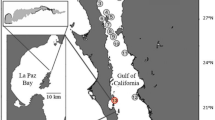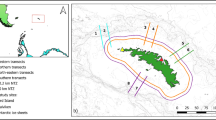Abstract
Inter-annual variability in the diet of Chinstrap penguins (Pygoscelis antarctica) at Laurie Island, South Orkney Islands was examined based on stomach contents of adults coming ashore during the 1997/1998–2001/2002 breeding seasons. Krill (Euphausia superba) dominated the diet either as frequency of occurrence (in 100% of samples), number (>99%), and percentage contribution in weight (>99.5%). Other prey items were minor but did vary between years. The contribution in weight of fish, amphipods and cephalopods ranged between 0.01–0.5, <0.01–0.14 and 0–0.03, respectively. Although minor components varied slightly along the years, the weight of stomach contents was significantly different. It was found that for a given weight the maximum observed percentage of undigested krill resulted negatively correlated with the stomach contents total weight. The proportion of whole krill observed in individual penguins, expressed as a fraction of the maximum corresponding to its weight was used to characterize the prevailing conditions in each season.






Similar content being viewed by others
References
Barrera Oro E (2002) The role of fish in the Antarctic marine food web: differences between inshore and offshore waters in the Scotia Arc and West Peninsula. Antarct Sci 14(4):293–309
Bowman T, Gruner HE (1973) The families and genera of Hyperiidea (Crustacea: Amphipoda). Smithsonian contributions to zoology, number 146
Castley JP, Cockcroft VG, Kerley GIH (1991) A note on stomach contents of fur seals Arctocephalus pusillus pusillus beached on the south-east coast of South Africa. S Afr J Mar Sci 11:573–577
CCAMLR (1980) Basic documents of the commission for the conservation of Antarctic marine living resources. Hobart, Australia, pp 76
CCAMLR, CEMP (2004) Standard methods for monitoring parameters of predators species. CCAMLR Ecosystem Monitoring Program. Hobart, Australia
Clarke M R (eds) (1986) A Handbook for the identification of Cephalopod beaks. Clarendon, Oxford
Clarke J, Kerry K, Irvine L, Phillips B (2002) Chick provisioning and breeding success of Adélie penguins at Béchervaise Island over eight successive seasons. Pol Biol 25:221–30. Springer-Verlag, Berlin
Cortez E (1997) A critical review of methods of studying fish feeding based on analysis of stomach contents: application to elasmobranch fishes. Can J of Fisheries and Aquatic Science 54:726–738
Croxall JP, Furse JR (1980) Food of chinstrap penguins Pygoscelis antarctica and macaroni penguins Eudyptes chrysolopus at Elephant Island Group, South Shetland Islands. Ibis 122:237–245
Croxall JP, Lishman GS, (1987) The food and feeding of penguins. In: Croxall JP (ed) Seabirds: feeding ecology and role in marine ecosystems. Cambridge University Press, London, pp 101–133
Croxall JP, McCann PA, Rothery P (1988) Reproductive performance of seabirds and seals at South Georgia and Signy Island, South Orkney Islands, 1976–1987: implications for Southern Ocean monitoring studies. Antarctic Ocean and resources variability. In: Sahrhage D (ed) Antarctic Ocean and resources variability. Springer, Berlin Heidelberg New York, pp 261–285
Croxall JP, Reid K, Prince PA (1999) Diet, provisioning and productivity responses of marine predators to differences in availability of Antarctic krill. Mar Ecol Prog Ser 177:115–131
Efron B , Tibshirani RJ (1993) An introduction to the bootstrap. Monographs on statistics and applied probability, vol 57. Chapman and Hall, New York, pp 436
Fraser WR, Trivelpiece WZ, Ainley DG, Trivelpiece SG (1992) Increases in Antarctic penguin populations: reduced competition with whales or a loss of sea-ice due to environmental warming? Polar Biol 11:525–531
Fraser WR, Trivelpiece WZ (1995) Palmer LTER: Relationships between variability in sea-ice coverage, krill recruitment and the foraging ecology of Adélie penguins. Antarct. JUS Rev 1995:271–272
Fraser WR, Trivelpiece WZ (1996) Factors controlling the distribution of seabirds: winter–summer heterogeneity in the distribution of Adélie penguin populations. Foundations for Ecological Research west of the Antarctic Peninsula. Antarct Res Ser 70:257–272
Gales RP (1987) Validation of the stomach flushing technique for obtaining stomach contents of penguins. Ibis 129:335–343
Hecht T (1987) A guide to the otoliths of Southern Ocean fishes. S Afr J Antarct Res 17:1–87
Hyslop EJ (1980) Stomach content analysis: a review of methods and their application. J Fish Biol 17:411–429
Hill HJ (1990). A new method for measurement of Antarctic Krill Euphasia Superba Dana from predator food samples. Polar Biol 10:317–320
Isaksen K, Hofney GJ, Dyer BM, Naestvold A, Mehlum F, Gjertz I, Bakken.V, Heyser O (1997) Preliminary results from CEMP Monitoring of Antartic Fur Seals, Chinstrap penguins and Macaroni penguins at Bouvetoya. CCAMLR/WG-EMM 97/20. Agenda item no 2
Jablonski B (1985) The diet of penguins on King George Island, South Shetland Islands. Acta Zool Cracov29(8):117–186
Jackson S, Ryan PG (1986) Differential digestion rates of prey by white-chinned petrels (Procellaria aequinoctialis). Auk 103:617–619
Jansen Kj, Boveng PL, Bengston Jl (1998) Foraging modes of Chinstrap penguins. Constrast between day and night. Mar Ecol Prog Ser 165:161–172
Jazdzewski K (1981) Amphipod crustaceans in the diet of pygoscelis penguins of the King George Island, South Shetlands, Antarctica. Pol Polar Res 2:133–134
Kozlov AN, Shust KV, Zemsky AV (1990) Seasonal and interanual variability in the distribution of Electrona carsbergi in the Southern Polar Front area (The area to the north of South Georgia is used as an example). Selected Scientific Papers. SC-CAMLR-SSP/7. CCAMLR Hobart, Australia, pp 337–368
Leon A, Fargallo JA, Moreno J (1998) Parental body size affects meal size in the Chinstrap penguin Pygoscelis antarctica. Polar Biol 19:358–360
Lishman GS (1985a) The food and feeding ecology of Adélie penguins (Pygoscelis adeliae) and Chinstrap penguins (P. antarctica) at Signy Island, South Orkney Islands. J Zool Lond 205:245–263
Lynnes AS, Reid K, Croxall JP, Trathan PN (2002) Conflict or co-existence? Foraging distribution and competition for prey between Adélie and chinstrap penguins. Mar Biol 141:1165–1174
Lynnes AS, Reid K, Croxall JP (2004) Diet and reproductive success of Adélie and Chinstrap penguins: linking response of predators to prey population dynamics. Polar Biol 27:544–554
Marschoff R, Gonzalez B (1992) Homogeneity of penguins as krill samplers. Selects Scientific Papers, SC-CAMLR-SSP/9. Hobart, Australia, pp 253–257
Miller DGM, Hampton I (1989) Biology and ecology of the Antartic krill (Euphasia superba Dana): a review. Biomass scientific series no 9. Published by SCAR and SCOR, Cambridge, England, pp 166
Montevechi WA (1993) Birds as indicators of change in marine prey stocks. In: Furness R, Greenwood J (eds) Birds as monitors of enviromental change 6:217–266
Moreno J, Barbosa, Potti J, Merino S (1997) The effects of hatching date and parental quality on chick growth and creching age in the Chinstrap penguin (Pygoscelis antarctica): a field experiment. Auk 114:47–54
Morris DJ, Watkins JL, Rickets C, Buchholz F and Priddle J (1998) An assesment of the merits of length and weight measurements of Antartic Krill Euphasia superba. In: British Antartic Survey Bulletin no 79, British Antarctic Survey. Natural Environment Research Council, Cambridge, pp 27–50
Obst BS (1985) Densities of Antartic seabirds at sea and the presence of the krill Euphasia superba. The Auk 102:540–549
Pakhomov EA, Perissinotto R (1996) Trophodynamics of the hyperid amphipod Themisto gaudichaudi in the South Georgia region during late austral summer. Mar Ecol Prog Ser 134:91–100
Pinkas L, Oliphant MS, Iverson ILK (1971) Food habits of albacore, bluefin tuna and bonito in California waters. Fish Bull Calif 152:105
Ramirez FC, Viñas MD (1985) Hyperiid amphipods found in Argentine shelf waters. Phys (Buenos Aires) 43:25–37
Rombolá E, Marschoff E, Coria N (2003) Comparative study of the effects of the late breaking of pack ice on Chinstrap and Adelia penguin´s diet and reproductive success at Laurie Island, South Orkneys Island, Antarctica. Polar Biol 26:41–48
SC-CCAMLR (2000) Report of the Nineteenth Meeting of the Scientific Committee, Annex 4 Report of the Working Group on Ecosystem Monitoring and Management (SC-CCAMLR XIX). CCAMLR, Hobart
SC-CCAMLR (2004) Report of the Twenty third Meeting of the Scientific Committee (SC-CCAMLR XXIII). CCAMLR, Hobart
Shao J, Tu D (1995) The Jacknife and the bootstrap. Springer series in statistics. Springer, Berlin Heidelberg New York, p 516
Siegel S, Castellan N J (1995) Nonparametric statistics for the behavioural sciences, 2nd edn. Cambridge University Press, De Trillas, pp 437
Trivelpiece WZ, Trivelpiece SG, Volkman NJ (1987) Ecological segregation of Adélie, gentoo and chinstrap penguins at King George Island, Antartica. Ecology 68:351–361
Trivelpiece WZ, Fraser W (1996) The breeding biology and distribution of Adelie penguins: adaptations to environmental variability. Antarct Res Ser 70:273–285
Williams RA, Mc Eldowney (1990) A guide to the fish otoliths from waters off the Australian Antarctic Territory, Heard and Macquarie Islands. Australian National Antarctic Research Expeditions. Res Notes 75:1–173
Williams TD (1995) The penguins. Oxford University Press, London, pp 295
Wilson RP (1984) An improved stomach pump for penguins and other seabirds. J Field Ornithol 55:109–112
Volkman NJ, Presler P, Trivelpiece W (1980) Diets of Pygoscelid penguins at King George Island, Antartica. Condor 82:373–378
Acknowledgements
We wish to thank members of Orcadas Station for their logistic help. We gratefully acknowledge the professional assistance of rangers of Administración de Parques Nacionales, G. Soave, V. Ferretti and G. Leotta. Dr. Gloria Alonso for her help in amphipods determination and Dr. Ricardo Casaux for his help in fish otolits determination.
Author information
Authors and Affiliations
Corresponding author
Rights and permissions
About this article
Cite this article
Rombolá, E., Marschoff, E. & Coria, N. Interannual study of Chinstrap penguin’s diet and reproductive success at Laurie Island, South Orkney Islands, Antarctica. Polar Biol 29, 502–509 (2006). https://doi.org/10.1007/s00300-005-0081-6
Received:
Revised:
Accepted:
Published:
Issue Date:
DOI: https://doi.org/10.1007/s00300-005-0081-6




